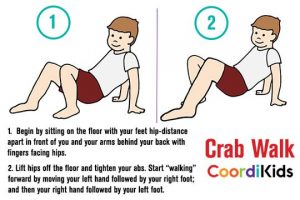General Information
Heavy Work Activities Your Children Will Love – And Benefit From

Did you know that there are certain exercises and types of play that your children can do will lead to great outcomes? These are movements that will boost their focus, attention span and ability to sit still in school.
In addition, they will improve the children’s ability to regulate their emotional outbursts. If you’re a parent using CoordiKids programs at home or school, you already know about heavy work activities. And, you will have heard us talk about proprioceptive input.
But we thought we’d share some activities that any parent could use to help their child. If you ensure your child is doing these activities at home or on the playground all week long, they’ll give their schooltime focus a much-needed boost!
Don’t worry, they’re quite simple. And even better, many of them are things your child might already be doing!
What are Heavy Work Activities?
“Heavy work” activities offer sensory feedback to the joints and muscles through heavy resistance, posture awareness, and unique movements of the body. This type of feedback is known as proprioceptive input.
Many studies have shown that proprioceptive input significantly supports emotional self-regulation and the response to sensory stimulation.
Heavy work activities are incredibly beneficial to children with disabilities. From ADHD and Sensory Processing Disorder to Autism Spectrum Disorder, heavy work activities are worthwhile.
But that’s not all. Neurotypical children and those without any disability have also been shown to benefit from proprioceptive activities.
Proprioceptive input:
- improves focus and concentration
- helps children self-regulate their emotions and calm themselves faster
- gives children a greater ability to sit still
- builds core muscles to counter-act the bad postural habits of screen-time.
If you’re like millions of parents, looking for a quick-fix type solution to these common challenges of modern childrearing, this is for you.
So, why not try some simple and fun tricks to incorporate heavy work activities into your child’s routine?
Heavy Work Your Child Might Already Be Doing
The good news is a lot of natural types of play your child is probably already doing are considered heavy work activities. Some examples include:
- Pushing someone else on a swing
- Climbing jungle gyms, monkey bars, rock walls and trees
- Climbing the ladder/stairs to a slide
- See saws / teeter totters
- Playing “catch” with a large ball
- Hanging and swinging from monkey bars
- Digging in the dirt or sandbox/sandpit
- Playing with play dough
- Jumping down from steps
Fun Ways to Add Heavy Work to Playtime
In addition to these activities, we have some more. Your child probably already experiences these activities on playgrounds or at school recess, but that’s not the limit!
Here are some fun ways to add unique heavy work activities to playtime for your child:
- Encourage your children and their friends to take turns pulling each other in a wagon
- Play “tug-of-war”
- Have crabwalk races or potato sack races
- Create an obstacle course race for your children and their friends.

Do it this weekend! You can go to a nearby playground! When there, define the course to include 5 to 8 of the following heavy work activities. Or, you can get creative with items around the house to create a course in your backyard!
The rules of the obstacle course are simple. Each person must complete the entire course in as little time as possible. (You can use the timer on most smartphones to track each child’s race time).
Put up a fun prize to the winner with the shortest time. Something like choosing dinner, getting an extra 30 minutes of TV or phone time will be popular. Additional ideas such as choosing the family movie, dessert, or extra money allowance will be a thrill!
To make the obstacle course even more fun for everyone involved, turn the obstacle course into a “gauntlet!” Line the observers on either side of the course, armed with water balloons, water guns, or silly string.
The runner of the gauntlet must complete the course while trying to avoid being hit! The course could include some of each of these types of heavy work activities:- Climbing stairs, a slide, or anything you can safely pile in your yard
– Hanging on to a horizontal bar for 5 seconds- Dragging a pillowcase full of books and tied close with a rope from one point to another- Jumping with feet together from one point to another- Pushing a box loaded down with books from one point to another
How to Incorporate Heavy Work Activities Into Your Everyday Routine
And, for some extra unique ways to sneak in some heavy work activities during your everyday routine, try some of these. (Hint: your kids won’t even know they’re doing special exercises!)
1. When walking around the house or school, go through a door first and push it closed behind you. Do this before your child has a chance to follow you through!
Keep some light pressure on the door while he or she is attempting to push open the door. This will likely become a fun prank for your whole family to play with each other.
Also, it provides great proprioceptive feedback to the joints and muscles as they push against the resistance.
2. Anytime you’re standing in line or waiting for an appointment, keep your little one from being bored or fussy doing this. Start a game by having them move like various animals back and forth between two points.
(Be courteous to people around you, of course. But, I find most people waiting nearby enjoy the distraction. They’re also usually interested in the clever ways of keeping kids from being bored without handing them a mobile device.)
Pick two points, about 10 feet apart, and ask your child to move from point to point. They can do this jumping like a frog, walking on all fours with their palms and feet, and doing a crab walk.
Just make sure you’ve got some hand sanitizer handy for afterwards! For older children, tell them they only have 10 seconds to get from point to point!
3. Ask your child to help you change the bed linens. Their reward is a short jumping-on-the-bed session before putting the fresh linens on or having a pillow fight with Mum or Dad!
4. Ask your child to carry the loaded laundry basket to and from their room.
5. Have your child help you carry bags of groceries into the house.
6. Anytime you’re coming down a flight of stairs, see how far your child can jump from the bottom step. This will quickly become a favorite habit of 2 – 5 year olds!
7. Let your little ones help vacuum, sweep, rake leaves or shovel snow.
8. Put your child in charge of watering the plants with a watering can.
9. Use a basket or toy box for your child to pick up toys at the end of the day and push the toy box back into the corner of the room.
BONUS TIP: Try some of these activities while your children are barefoot.
“Feet are one of the most sensory-rich parts of the human body. The soles of the feet are extremely sensitive to touch, and there are large concentrations of proprioceptors in the joints and muscles of the feet.
In fact, the feet alone have as many proprioceptors as the entire spinal column!” Kacie Flegal, D. C.
Read more about barefoot play boosting brain development here: Allowing Children Barefoot Play in the Garden Boosts Brain Development (& more!)
Send us a photo of your children practicing heavy work activities this summer!
Share them with us on our Facebook page www.facebook.com/Coordikids/ – you never know when you might get a prize for contributing!